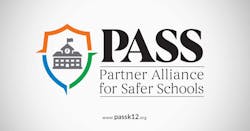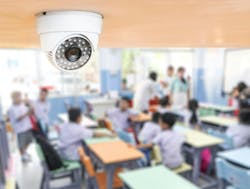The Skinny
- PASS is releasing the 7th edition of its school safety guidelines, with updates to key components such as access control and video surveillance.
- Access control updates emphasize locked classroom doors, secure visitor entry points, and clear signage, as well as visitor management systems that include electronic tracking and identity verification.
- The new Digital Infrastructure Layer introduces cybersecurity guidance aligned with NIST standards, designed to be accessible for both IT professionals and educators new to cybersecurity responsibilities.
The Partner Alliance for Safer Schools (PASS) continues to bring the brightest minds together in a concerted effort to provide schools with the knowledge, resources and support to make informed decisions along the path to creating safer and more secure schools. Established in 2014, PASS is set to release the seventh edition of its guidelines (see 6th edition updates), which provide school administrators, school boards and public safety and security professionals with information, tools and insight needed to implement a tiered approach to securing and enhancing the safety of school environments based on their individual needs, nationwide best practices, and the most effective use of resources available.
At a recent PASS town hall meeting, several members from the PASS team went over some of the key updates to the new edition of guidelines, including updates to the video surveillance component, access control component, communication component and district wide layer, as well as the introduction of a new digital infrastructure layer that addresses cybersecurity and data protection/privacy.
Access Control Updates
Because the access control component is at the core K-12 school security, PASS continues to focus on building out this area with more guidance and resources. In addition to recommending that classroom doors remain “closed and locked at all times,” the seventh edition contains a new door lock matrix that provides guidance on which locks are suitable and recommended for the K-12 environment, as well as several options based on different schools’ needs.
The access control component also contains recommendations for creating a secure visitor entry area (also referred to as secure vestibule entrances), and PASS provides white papers on this topic that focus on the importance of having a single point of entry for a school as well as having a visitor management system.
PASS recommends that all exterior doors be locked and monitored for closed and locked status, as well as installing clear wayfinding signage directing visitors from anywhere on the campus to the appropriate visitor entrance, as well as informational signage at the door explaining the proper procedure for gaining access to the building. Ideally while still on the exterior of the building, visitors should be able to utilize indirect communication with staff through an intercom or phone system prior to gaining access to any portion of the building. Utilizing a video doorbell system at the exterior visitor entrance door enables staff to interact with a visitor with both audio and video, allowing visual identification.
“This access control component is the central nervous system for a school district,” says Michael Garcia, National K-12 End User Business Manager at HID, who is on the PASS Advisory Board. “We want to be able to command, contain, control and communicate … to have visualization, actionable intelligence and situational awareness within the school and the entire school district, which is why we are all talking so much about unification at this town hall.”
Visitor Management
PASS Advisory Board Chair Guy Grace, and K-12 National Security Program Manager at ASSA ABLOY, points out that the guidelines also provide best practices for critically important visitor management systems.
“These systems provide a streamlined and efficient way to monitor and control the flow of visitors, ensuring that only authorized individuals have access to the school premises,” he explains, noting that the PASS white paper on the topic aims to give schools an overview of visitor management systems and recommendations for creating a safe and secure learning environment.
“By requiring visitors to check in, provide identification and obtain a visitor badge, the school can easily identify anyone on campus and quickly respond to potential security threats,” he says. “Moreover, these systems create a comprehensive record of visitors, enabling the school to track and manage who enters and exits the facility.”
PASS recommends that every school should have a visitor badging system. While these systems can range from basic to advanced, at a minimum, visitor badges should be issued to all visiting individuals who are not staff or students. Moreover, PASS recommends the use of an Electronic Visitor Management System (EVMS), which streamlines the visitor sign-in process and tracks specific visitor data such as who is entering the school, when they enter, the reason for the visit, and who they are visiting.
“Many systems record photos of the visitors or scan driver’s licenses that are presented by visitors not only to help confirm the presenter’s identity but also to check for persons that should not be permitted to enter for various reasons, such as restraining orders or parental rights disputes,” Grace explains. “This usually involves checking the ID against National Sex Offender Registries but can also involve criminal background checks.”
Video Surveillance Updates
With so much change and evolution with video surveillance, and cameras integrating so closely with access control and visitor management, the seventh edition’s updates include information on enhanced camera placement and recommended field of views, and classroom camera recommendations. In addition, analytics were added, with guidance on the capabilities of today’s cameras and how the latest technologies can benefit those trying to secure the K-12 setting.
“What we've tried to do is develop the guidelines that would help that administrator who's sitting behind the desk and really is not sure what to do, what steps to do, and what to focus on and prioritize,” says Jim Crumbley, President/CEO, Risk Response Team, Inc., a PASS advisory board member who provided some context for some the new video updates at the town hall. “We've established operational requirements for each camera that involves step one, which would be detection, moving to observation, recognition and identification.”
Another important addition to the guidelines is classroom cameras. “That's probably one of the most controversial things we've added in video since we came out with the guidelines in revision one,” explains Crumbley. “But I think it's important now for us to understand that classroom cameras are very useful.”
While video has become a vital component of school safety protocols, as Crumbley points out the introduction of cameras in classrooms often brings with it significant debate over privacy, including the use, accessibility, and oversight of recorded material and whether audio recording is included. “It is essential to navigate these issues carefully, ensuring compliance with legal standards and safeguarding individual rights,” he says.
The addition of video analytics is another area that can benefit schools greatly. “We've added people identification, and things like field of views at pickup and drop-off areas, and we want to be able to identify the student who's getting into the car, if people are getting out, and who that child is going with, for example,” Crumbley explains. “And so that camera really needs to be a top-notch camera with video analytics, such as noise detection and weapon analytics. A lot of these analytics have gotten better and better and less expensive. So as schools have begun to build upon their foundation on video, we want them to start taking advantage of video analytics.”
Mobile Credential Recommendations
As mobile credentials have become a part of everyday life in the higher ed setting, PASS is educating schools on how to best leverage this technology in the K-12 setting.
“Mobile Credentials, when used with the First Responder door numbering system for card reader locations and unified life systems, are a true game changer,” says Grace. “They offer unmatched rapid emergency response for law enforcement and EMS personnel. When used in combination with Mobile Duress (pinpoint accuracy) and Secure Vestibule entrances, they could easily become the next ‘standard issue’ in the first responder’s toolbelt.”
He continues, “Mobile credentials offer solutions for emergency situations across all hazards in the K-12 Environment. As an incident command tool for multiple mass campus events where every school is put on lockdown, they are invaluable, enhancing the ability for students to learn and teachers to teach.”
PASS 7th Edition Updates at a Glance
Access Control Component Updates
· New Door Lock Matrix
· Classroom Doors Closed and Locked at All Times
· Secure Visitor Entry Center
Video Surveillance Component Updates
· Updated and Enhanced Camera Placement
· Updated recommended Field of Views
· Tier II Recommendations to Tier I
· Analytics Added
· Classroom Camera Recommendations
District Wide Layer Updates
· Holistic Interoperability Approach
· Security Operations Centers
· Unification of Systems
Communication Component Updates
· District Wide Approach to Unified Communication
· Audio AND Visual Communication
· Addresses Panic Alarms
NEW Digital Infrastructure Layer
· Address Cybersecurity across District and Schools
· Data Protection/Privacy
· New Checklist
New Digital Infrastructure Layer
The seventh edition of the PASS guidelines will include a new digital infrastructure layer that addresses cybersecurity and data protection/privacy. The creation of this new layer was led by Will Knehr, Global cybersecurity advisor, i-Pro Americas, who provided some insight into what the new guidelines at the PASS town hall.
“When I got approached by [PASS Chair] Chuck Wilson and [PASS Volunteer of the Year] Scott Lord to do a digital infrastructure layer, we initially we focused on cybersecurity, and then we moved it out to digital hygiene, in general,” Knehr explains. “Our approach for this was, we can provide guidance not only for an advanced cybersecurity person, but even if you are just getting started in cyber. If you are a math teacher, or an English teacher, and have suddenly been given cybersecurity over for the organization. Where can you start out? How can I approach this?”
Knehr points out that K -12 institutions are prime targets for hackers. “That's because these institutions typically have a lower level of cybersecurity and they tend to pay out for ransomware, and so ransomware hackers absolutely love to go after these types of schools.”
The PASS cyber guidelines align with the National Institute of Standards and Technology (NIST) recommendations, but with language that can be understood by those who may be starting without a ton of prior knowledge.
“NIST is the gold standard for cybersecurity, and we took that [framework] and then we modified it, made it something that would be easy to understand,” Knehr explains. “As we're sitting there in these meetings and we're explaining all these advanced cybersecurity concepts, I see Scott's face just like dropping and draining, so we morphed this into something that anyone can take in. We changed a lot of the verbiage, and then we also added a lot of examples of what this looks like if you were to roll this into a school.”
With this being a new layer to the seventh edition of PASS guidelines, Knehr sees this as an evolving product. “Especially as schools are going to start embracing artificial intelligence a lot more and moving to more hybrid approaches for learning. This framework we’ve created should be something that can be rolled out in tier one and should be able to be implemented in any K-12, all the way up to our more advanced stuff.”
About the Author
Paul Ragusa
Senior Editor
Paul Ragusa is senior editor for Locksmith Ledger. He has worked as an editor in the security industry for nearly 10 years. He can be reached at [email protected].


